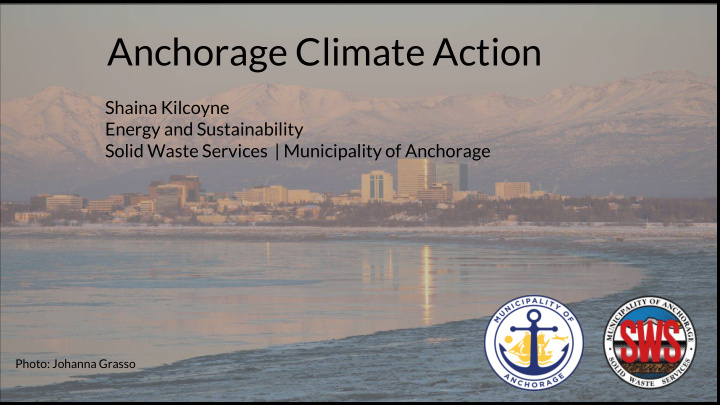



Anchorage Climate Action Shaina Kilcoyne Energy and Sustainability Solid Waste Services | Municipality of Anchorage Photo: Johanna Grasso
Changing Climate in Anchorage
Climate Action Plan Implementation Mayor’s Resilience Sub -Cabinet Anchorage Climate Action Council
Climate Action Plan Student Engagement Polaris Submitted 25 Resolutions and presented to the Assembly Chugiak High School Submitted dozens of comments during the Public Comment Period
What is ASD’s strategy on climate action? A. Think inside the box B. Think outside the box C. What’s a box? D. All of the above
● Improve energy efficiency in Municipally owned buildings ● Increase opportunities for residents and businesses to implement clean energy technology ○ Strengthen building energy standards ○ Provide financing opportunities ○ Offer incentives ○ Reduce barriers 1C: Implement energy performance tracking and an annual reporting program for buildings over 10,000 square feet, starting with municipal buildings.
Improve energy efficiency in ASD buildings Annual Energy Costs Electric: $10.8M Gas: $4.6M Total: >$15M or ~$2/ sf ASD could save approximately $3M in energy and O&M costs per year through investment of approximately $21M* *Assumptions: 1. Simple payback for energy efficiency upgrades is 7 years 2. 20% of ASD facilities have already received an energy upgrade
Energy in ASD buildings GVEA Homer Electric MEA Chugach MLP
Improve energy efficiency in ASD buildings What is ASD Doing? Monitoring Energy Use ● Replacing Lighting ● Upgrading boilers to high ● efficiency condensing boilers Converting to VFDs ● Upgrading refrigeration ●
Improve energy efficiency in ASD buildings What more could ASD do? Continue energy efficiency upgrades as funding allows ● Re-invest energy savings into more efficiency upgrades ● New facilities with energy efficient design ● Reduce Vampire Loads - power save mode on electronics ● Create dashboards with real-time feedback / energy competitions between ● schools Ensure energy use info gets to the right people ● What more could the Assembly do? Continue to support bonds for energy efficiency improvements ● Work with ASD finance and facilities managers to determine whether loan ● products are a good fit for energy upgrades - traditional loans, ESCOs, or public financing
Renewable energy in ASD buildings Kidwind Challenge, REAP Begich Middle School Wind Turbine
Solar energy in ASD buildings Solar Prices have fallen 32% over the last 5 years Alaska has approximately 75 Solar Industry jobs Solar has nearly doubled in 2019 compared to previous years
● Housing infill and redevelopment to minimize car travel and increase community resilience ● Increase use of public transit and non-motorized transportation ● Electrifying vehicle fleets and promote energy efficient vehicles 6C: Promote the reduced fare program on People Mover and expand youth (under 18) ride free.
Upgrade bus fleet Volkswagen Settlement Funds: School bus replacement - $3.4M March 2019: 6 buses September 2019: ? 80% NOx Reduction
Electric Buses in the future? 2018 Pilot Study: Solid Waste Services and People Mover
● Increase recycling, composting, and other diversion of waste to increase the life of the landfill ● Capture more potential energy in collected refuse (e.g., organics digestion, mass burn, and landfill gas to energy expansion) ● Expand diversion opportunities by building a new Central Transfer Station 9A: Generate and enact policy (internal and external to MOA) to increase diversion, including policies that look ‘upstream’ like Extended Producer Responsibility.
What is ASD Doing? Partnering with Solid Waste Services and ● Alaska Waste to fund a Recycling Position Food scrap collections at high and ○ middle schools Increase participation in the green ○ schools program Introducing reusable trays ● Offers recycling at 5 schools: ● West High ○ East High ○ Service High ○ Bartlett High ○ Assembly Proclamation naming Nov. 15 Anchorage Recycles Day
● Improve household wildfire mitigation ● Identify and develop key secondary access routes for emergency response and evacuation in the Hillside, Girdwood, Eagle River/Chugiak ● Improve language access to all residents on climate change, natural hazards, and emergency preparedness 14D: Expand visibility of the Anchorage Air Quality Index including particulate matter and pollen counts so that the public is aware of bad air quality days.
● Support school and community gardens and other opportunities to expand community growing ● Encourage farmers markets to accept payment through food assistance programs ● Conduct a commercial organic waste collection pilot 19C: Analyze existing Municipality of Anchorage purchasing and procurement policies and explore creating a preference for purchasing locally grown (i.e. Alaska Grown) foods. Photo Credit: Michelle Fehribach
● Develop an urban forest management plan ● Create a stormwater utility ● Continue to support APU efforts to monitor Eklutna Watershed 22F: Promote and expand weed pulls, tree plantings, spruce beetle identification and management, wildfire mitigation, and other educational activities that promote stewardship among the public, businesses, and homeowners.
● Increase outreach methods for participation in planning and new programs ● Develop an online Anchorage climate action webpage and other outreach materials ● Encourage education about climate change, energy, and the development of career and technical education programs around clean energy jobs 28C: Encourage education about climate change, energy use, and outdoor/natural sciences through K-12, post- secondary, continuing adult education, and extra-curricular education.
28C Cont’d: (1) conduct an inventory of existing curriculum and (2) identify, incentivize, and provide materials and resources to educators
Coffman Cove Biomass Heated Greenhouse Economic Development STEM Education Healthy Lifestyle
How Can We Collaborate? Shaina.Kilcoyne@anchorageak.gov 744-1815 Photo: Johanna Grasso
Recommend
More recommend